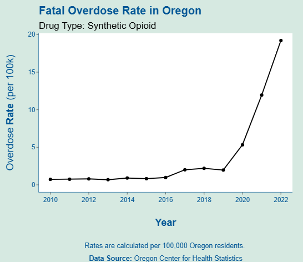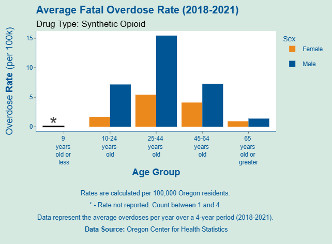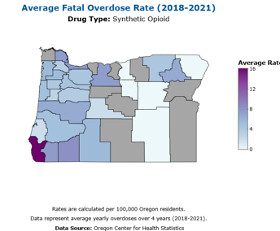Introduction
Although it is particularly pronounced in Oregon, there is no question that the fentanyl epidemic is imposing severe economic costs across the nation. The current report quantifies some of these costs and describes the state policy environment. Public policy regarding drug use is evolving rapidly in Oregon as we speak. As with all CSI does, the primary goal of this report is to educate and inform Oregonians on policy issues such as this that impact their lives.
Key Findings
- The economic cost of Oregon’s fentanyl crisis is more than $31 billion annually, up from $5.88 billion in 2017.
- Enough fentanyl was seized last year to kill every Oregonian more than 20 times over.
- Most western states have seen above-average growth in fentanyl use during recent years. Even so, Oregon’s experience stands out relative to its neighbors. Since the pandemic began, fentanyl-related overdose deaths in Oregon have increased by over 1,000%, more than in any other state. Alaska’s experience is the only one that even comes close.
- Although Oregon’s decriminalization experiment cannot be blamed for all the disproportionate local impact of the fentanyl epidemic, it is clearly playing a role. When decriminalization went into effect in February 2021, Oregon ranked 38th out of 48 states with available data in the rate of fentanyl-related overdose deaths. By January 2024, Oregon’s rank rose to 13th.
- Many voters and policymakers quickly experienced regrets associated with the decriminalization effort and are making some efforts to improve the law. During the 2023 legislative session, legislators enacted House Bill 4002, which created a new misdemeanor for simple drug possession. The new law gives leeway to counties on how to implement it locally, and we are likely to learn much as the different programs evolve.
Oregon’s Fentanyl Crisis
Fentanyl is much more dangerous than other drugs – even including peer opioids. According to the CDC, fentanyl is up to 50 times stronger than heroin and 100 times stronger than morphine. It can be fatal at smaller doses, and its inclusion in counterfeit prescription pills puts users at high risk of accidental overdose. Across the U.S, there are 150 deaths every day from overdoses related to synthetic opioids like fentanyl.
In just a handful of years, fentanyl-related overdoses in Oregon have gone from very few to the dominant source of drug-related deaths and hospitalizations, far outstripping the damage caused by heroine, methamphetamine and other drugs of abuse.

With fentanyl’s rise having started earlier on the east coast, western states have seen above-average growth in its use during recent years. Even so, Oregon’s experience stands out relative to its neighbors. Since the pandemic began, fentanyl-related overdose deaths in Oregon have increased by over 1,000%, more than in any other state. Alaska’s experience is the only one that comes close.
[i]

Narcotics Seizures in Oregon
Laboratory testing of 7 out of every 10 pills seized by the DEA contains a lethal dose of fentanyl. The DEA also states that 2milligrams of fentanyl is enough to kill the average American.
[ii] CSI uses this data in combination with fentanyl seizure data from the Oregon High Intensity Drug Trafficking Area (HIDTA) to estimate the potential deaths from seized fentanyl.
[iii]
The following table shows the fentanyl seized in powder form and pill form, the potential number of deaths posed, and the number of times each Oregonian could be killed by seized fentanyl. The potential number of deaths form fentanyl rose 10,239% from 212,800,000 in 2019 to 283,620,000 in 2023. The number of times each Oregonian could be killed by seized fentanyl rose 10,279% from 0.2 in 2019 to 22.2 in 2023.
| Fentanyl Seizures in Oregon 2023 |
|
Quantity of fentanyl powder Seized |
Quantity of fentanyl pills seized |
Milligram
equivalent of pills seized |
Lethal Dosage |
Potential Deaths (people) |
Population of State |
Potential Deaths per Person |
| 2019 |
1,520,000 mg |
101,859 |
425600000 mg |
2 mg |
212,800,000 |
4,217,737 |
0.2 |
| 2020 |
200,000 mg |
713,247 |
17,870,000 mg |
2 mg |
8,935,000 |
4,237,256 |
0.3 |
| 2021 |
900,000 mg |
1,353,426 |
119,300,000 mg |
2 mg |
59,650,000 |
4,246,155 |
0.6 |
| 2022 |
44,400,000 mg |
2,944,823 |
4,580,000 mg |
2 mg |
2,290,000 |
4,240,137 |
6.2 |
| 2023 |
176,800,000 mg |
3,455,673 |
567,240,000 mg |
2 mg |
283,620,000 |
4,197,736[iv] |
22.2 |
| % Change
2019-2023 |
11,531.6% |
3,292.6% |
3,292.6% |
|
10,229.9% |
-0.5% |
10,279.1% |
The Economic Costs of the Oregon Opioid Epidemic
In its 2017 report,
State-Level Economic Costs of Opioid Use Disorder and Fatal Opioid Overdose, the CDC estimated the total economic cost of the opioid epidemic in the United States at the time at $1 trillion. Oregon’s share of those costs was more than $12 billion (Opioid use disorder $3.9B + fatal opioid overdose $8.2B). Updating these estimates for inflation and overdose rates in 2023, and factoring in the share of those overdoses that are caused by fentanyl leads to a current statewide cost of more than $31 billion for fentanyl alone.
| Total Economic Cost of Opioid Overdose Use Disorder and Overdose Death in Oregon |
|
Case Count of Opioid Use Disorder |
Number of Opioid Overdose Deaths |
Cost of Opioid Use Disorder |
Cost of Fatal Opioid Overdose |
Combined Cost of Opioid Use Disorder and Fata Opioid Overdose |
Per Case Count Cost of Opioid Use Disorder |
Per Case Cost of Fatal Opioid Overdose |
Combined Cost of Fentanyl Use Disorder and Fentanyl Overdose Deaths |
| 2017 |
37,000 |
344 |
$8.19B |
$3.97B |
$12.16M |
$221,219 |
$11.55M |
$5.88B |
| 2023 |
148,000 |
1,375 |
$43.87B |
$21,29B |
$65.16B |
$296,434 |
$15.48M |
$31.55B |
To compute cost estimates, the CDC considered healthcare costs, lost productivity, and the cost of lost lives. Clearly, there are many more costs associated with the epidemic, albeit hard to measure. For one, local labor markets are being permanently damaged. The CDC estimates are based on a single year, and do not measure lost lifetime earnings. Not only is fentanyl use concentrated among individuals in their peak earning years, but also among younger workers who are generating their lifetime earning potential. Every year of lost educational attainment, experience within an industry, and tenure within a given firm weighs on lifetime earnings. Employers suffer hand-in-hand with their workers. With around 20,000 baby-boomers retiring each year in Oregon, the labor market will remain tight with workers hard to find for some time.

In addition to labor market impacts, factors such as increased homelessness and crime bring with them considerable costs. The Oregon Criminal Justice Commission estimates that around 29% of potential misdemeanors for possession of a controlled substance, occur in conjunction with other misdemeanors. Of course, additional criminal acts can be driven by addiction even if there are no drugs on hand at the time. These sorts of costs are particularly concerning in Oregon given the state’s traditionally strong migration trends. The attractiveness of our large population centers to visitors has been one factor that draws households to the state.
Statewide Policy: The Fallout from Ballot Measure 110
With overwhelming support from Oregon voters in 2020, Ballot Measure 110 (codified in Senate Bill 755-C) decriminalized most possession of drugs, including opioids. Measure 110 reduced the penalties for possession of controlled substances from felonies and misdemeanors to a Class E violation punishable by a $100 maximum fine. The law also funneled hundreds of millions of dollars in cannabis funds into addiction screening and treatment programs. Participating in treatment resulted in any fines being waived.
The complex law got off to a rocky start, given the need for education and the build-up of infrastructure. Law enforcement officers issued few fines, and few individuals took advantage of treatment resources. Given a short implementation period, funds were slow to be released. A shortage of detox and treatment services persists in Oregon to date.
Drug decriminalization in Oregon could not have come at a worse time, coinciding perfectly with the surge in fentanyl use. Again, while most western states have seen disproportionately large increases in overdoses and hospitalizations, Oregon’s experience has been an outlier. The impacts of Measure 110 are clearly playing a role. Before the law went into effect in February 2021, Oregon ranked 38
th out of 48 states with available data in the rate of fentanyl-related overdose deaths. By January 2024, Oregon’s rank rose to 13
th.
Statewide Policy: The Pendulum Begins to Swing Back with HB 4002
Many voters and policymakers quickly experienced buyers’ remorse associated with the decriminalization effort. During the 2023 legislative session, policymakers enacted House Bill 4002, which created a new misdemeanor for simple drug possession. The law also stiffened penalties for dealing, and devoted additional resources to mental health and addiction services. According to the Oregon Criminal Justice Commission, the law is expected to result in 1,269 successful deflections, 381 conditional discharge sentences, and 2,257 misdemeanor convictions per year.
HB 4002 passed with strong bipartisan support. The most commonly reason cited among those who objected, was that it would disproportionately harm communities of color. Overdose rates are relatively high among communities of color. Drug convictions are relatively higher still. During deliberations, the CJC produced equity estimates for HB 4002:282856 (oregonlegislature.gov) .

HB 4002 is just a small first step and will continue to evolve over time as investments in infrastructure are made, and counties determine the best way to implement the law. The law provides for a considerable amount of flexibility in implementation across counties, and local policymakers and law enforcement are choosing a wide range of paths. To date, 23 of Oregon’s 36 counties have accepted state funding to set up deflection infrastructure, to funnel individuals into detox and treatment. Participating counties account for around four in five Oregonians.
One size does not fit all. Most of the counties that have turned down the additional state funds are smaller rural communities that have fewer local resources or those that prefer to impose penalties rather than offer deflection. While the law included additional funding, there remain gaps. These gaps include state money for pre-trial detention, law enforcement and bridging Oregon’s shortage of public defenders. On the other end of the spectrum is Multnomah County, home to downtown Portland. Although policies are still being developed, the current plan is to create drop-off centers to deliver individuals found possessing drugs. If an individual is checked into a drop-off center, services will be made available, but no addiction screening or drug treatment will be mandatory. There is no planned limit on how often an individual can take advantage of the drop-off center pathway. Other large counties are currently planning a middle route, where offenders are offered deflection, but future penalties are dependent on successful participation in deflection services. With rates of overdose deaths and hospitalizations varying widely across the state, different polices are warranted for different regions. It remains to be seen which will prove most successful.

The Bottom Line
The severity of Oregon’s fentanyl epidemic caught everyone by surprise. In hindsight, Oregon’s popular and novel drug decriminalization effort could not have come at a worse time. Policymakers are currently making a concerted effort to improve the law, but the effort is still in its infancy. There remain many more lessons to learn going forward.
[ii] https://www.dea.gov/onepill
[iii] https://oridhidta.org/fentanyl-information
[iv] https://www.koin.com/news/oregon/census-data-shows-oregon-population-growth-noticeably-slowed-in-2023/